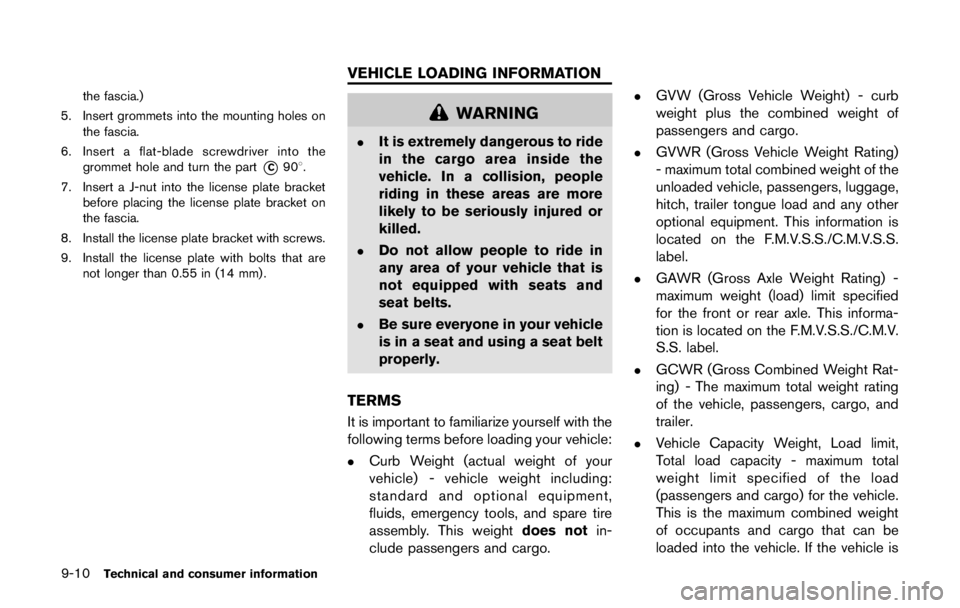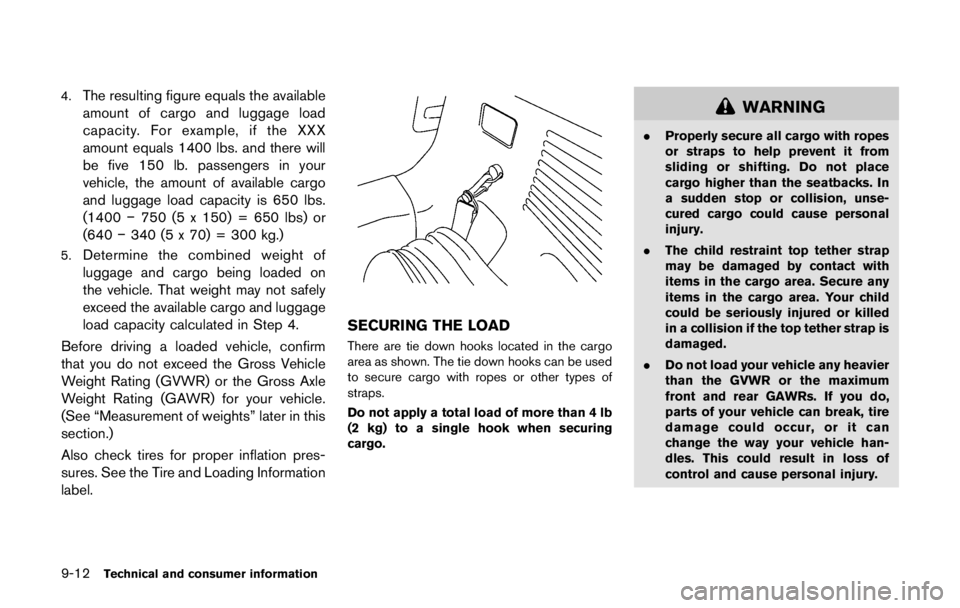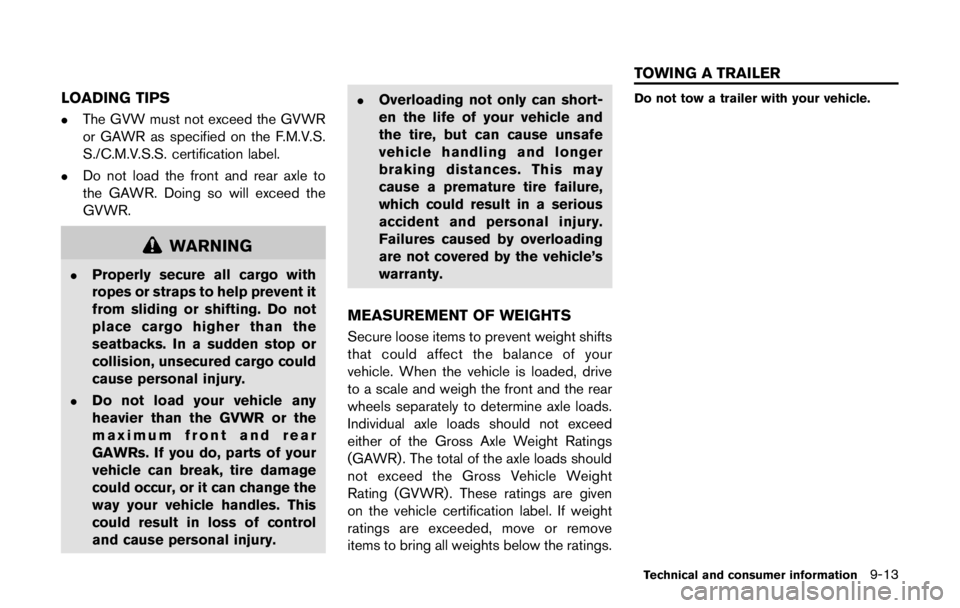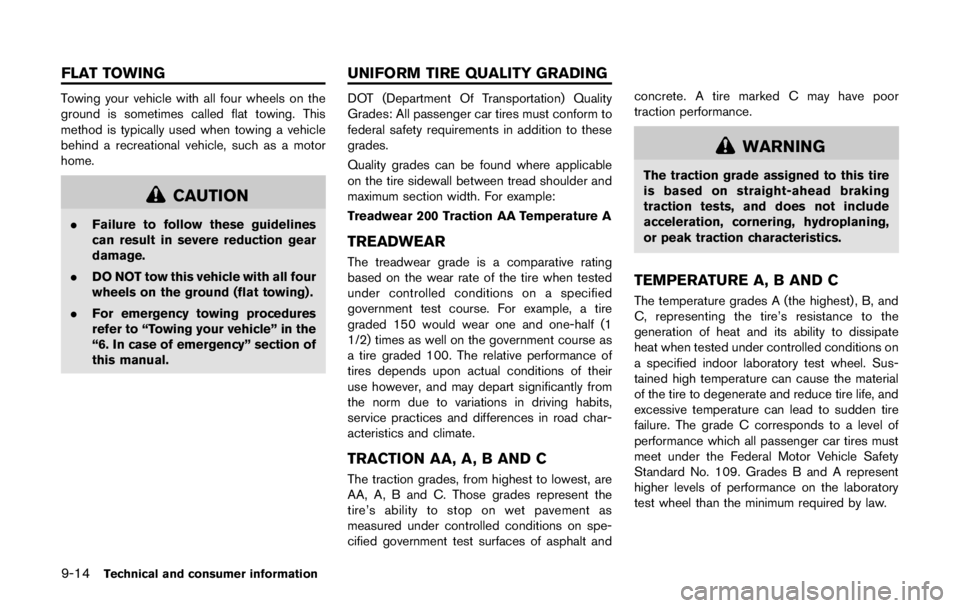NISSAN LEAF 2011 Owners Manual
LEAF 2011
NISSAN
NISSAN
https://www.carmanualsonline.info/img/5/56729/w960_56729-0.png
NISSAN LEAF 2011 Owners Manual
Trending: load capacity, washer fluid, coolant, change time, coolant level, power steering, battery replacement
Page 331 of 1062

WARNING
.If you use any medical electric
devices, such as an implantable
cardiac pacemaker or an implanta-
ble cardiovascular defibrillator,
check with the electric medical de-
vice manufacturer concerning the
effects that charging may have on
implanted devices before starting
the charge operation. Charging
may affect the operation.
. If you have an implantable cardiac
pacemaker or an implantable cardi-
ovascular defibrillator, while the Li-
ion battery is charging:
— Do not stay inside the vehicle.
— Do not go inside the vehicle, for
example to remove or place an
item in the passenger compart-
ment.
— Do not open the rear hatch, for example to remove or place an
item in the cargo area.
Charging may affect the operation
of electric medical device and result
in serious personal injury or death. .
Make sure there is no water or
foreign materials in the charge port,
charge connector or electrical plug,
and that they are not damaged or
affected by rust or corrosion. If any
of these conditions are noticeable,
do not charge the Li-ion battery.
This may result in a short circuit or
electric shock and could cause a fire
which may result in serious perso-
nal injury or death.
. To avoid serious personal injury or
death when the Li-ion battery is
charging, be aware of the following
precautions.
— Do not touch the metal contacts
of the charge port, charge con-
nector or electrical plug.
— Do not touch the vehicle and charger when there is lightning.
A lightning strike may back feed
into the charger causing da-
mage and possible personal in-
jury or death.
. Make sure the charge connector is
removed from the charge port be-
fore starting your vehicle. If the
charge connector is only partially engaged and the connector latch is
unlocked, it is possible to place the
EV (Electric Vehicle) in the READY
to drive position.
. Do not plug in or unplug the plug
with wet hands and do not stand in
water, liquid or snow. This may
cause an electric shock which may
result in serious personal injury or
death.
. Do not disassemble or modify the
charge port or the EVSE (Electric
Vehicle Supply Equipment) . This
may cause a fire.
. If you notice an unusual odor or
smoke coming from the vehicle,
stop charging immediately.
. Be careful not to allow your hands,
hair, jewelry or clothing to come into
contact with, or get caught in, the
traction motor cooling fan. The cool-
ing fan can start at any time during
charging.
PRECAUTIONS ON CHARGING
Page 332 of 1062

.Pass the lower side belt of the EVSE
(Electric Vehicle Supply Equipment)
case securely through the fastener
on the bottom of the luggage board.
If the case suddenly becomes loose,
it may cause serious injury or death.
CAUTION
.To prevent damage to the charging
equipment:
— Do not close the charge port lid
without closing the cap. — Do not subject the charging
equipment to impact.
— Do not pull or twist the charge cable.
— Do not drag the charge cable.
— Do not store and use charging equipment in locations where
the temperature is over 1858F
(858C) .
— Do not place the charging equip- ment close to a heater or other
heat source.
. Make sure the cap is closed on the
charge port when charging is fin-
ished. If the charge port lid is closed
when the cap is open, water or
foreign materials may enter the
charge port.
. Do not charge when a vehicle body
cover is in use. This may cause
damage to the charge connector.
. Do not attempt to perform a jump
start on the 12-volt battery at the
same time that the Li-ion battery is
being charged. Doing so may da-
mage the vehicle or charging equip- ment and could cause an injury. See
“Jump starting” in the “6. In case of
emergency” section.
. Trickle charging is performed using
the EVSE (Electric Vehicle Supply
Equipment) provided with the vehi-
cle. NISSAN recommends using an
AC 110 - 120 volt, 15A, dedicated
electrical circuit and outlet. The
dedicated circuit is used to help
prevent circuit damage or the circuit
breaker from tripping due to the
high draw of charging the Li-ion
battery. If the dedicated circuit is
not used, the circuit may cause
adverse interference on MCB
(Moulded Circuit Board) and house-
hold electrical appliances such as
televisions and audio systems. If the
circuit is shared, and another elec-
trical device is being used at the
same time the vehicle is charging,
the breaker may trip. A licensed
professional electrician should in-
stall a dedicated circuit if one is not
already available.
ChargingCH-3
Page 333 of 1062
Page 334 of 1062
Page 335 of 1062
Page 336 of 1062
Page 337 of 1062
Page 338 of 1062
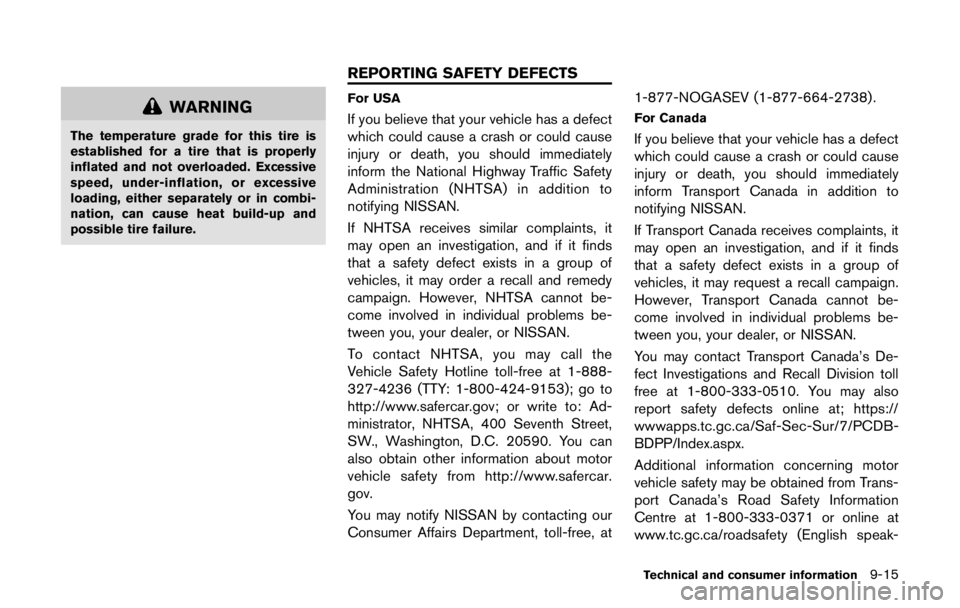
WARNING
.The front air bags ordinarily will not
inflate in the event of a side impact,
rear impact, rollover or lower sever-
ity frontal collision. Always wear
your seat belts to help reduce the
risk or severity of injury in various
kinds of accidents.
. The front passenger air bag will not
inflate if the passenger air bag
status light is lit or if the front
passenger seat is unoccupied. See
“Front passenger air bag and status
light” later in this section.
. The seat belts and the front air bags
are most effective when you are
sitting well back and upright in the
seat with both feet on the floor. The
front air bags inflate with great
force. Even with the NISSAN Ad-
vanced Air Bag System, if you are
unrestrained, leaning forward, sit-
ting sideways or out of position in
any way, you are at greater risk of
injury or death in a crash. You may
also receive serious or fatal injuries
from the front air bag if you are up
Safety—Seats, seat belts and supplemental restraint system1-37
Page 339 of 1062

against it when it inflates. Always sit
back against the seatback and as
far away as practical from the steer-
ing wheel or instrument panel. Al-
ways use the seat belts.
. The driver and front passenger seat
belt buckles are equipped with
sensors that detect if the seat belts
are fastened. The Advanced Air Bag
System monitors the severity of a
collision and seat belt usage then
inflates the air bags as needed.
Failure to properly wear seat belts
can increase the risk or severity of
injury in an accident.
. The front passenger seat is
equipped with occupant classifica-
tion sensors (weight sensors) that
turn the front passenger air bag
OFF under some conditions. This
sensor is only used in this seat.
Failure to be properly seated and
wearing the seat belt can increase
the risk or severity of injury in an
accident. See “Front passenger air
bag and status light” later in this
section. .
Keep hands on the outside of the
steering wheel. Placing them inside
the steering wheel rim could in-
crease the risk that they are injured
if the front air bag inflates.
Page 340 of 1062
WARNING
.Never let children ride unrestrained
or extend their hands or face out of
the window. Do not attempt to hold
them in your lap or arms. Some
examples of dangerous riding posi-
tions are shown in the illustrations.
. Children may be severely injured or
killed when the front air bags, side
air bags or curtain air bags inflate if
they are not properly restrained.
Pre-teens and children should be
properly restrained in the rear seat,
if possible.
. Even with the NISSAN Advanced Air
Bag System, never install a rear-
facing child restraint on the front
seat. An inflating front air bag could
seriously injure or kill your child.
See “Child restraints” earlier in this
section for details.
Safety—Seats, seat belts and supplemental restraint system1-39
Trending: change time, radio, child seat, wheel size, battery replacement, technical specifications, oil


